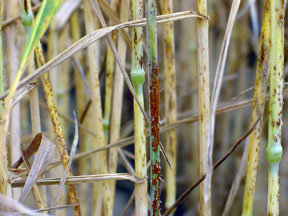Preharvest wheat disease update
Editor’s note: This article is from the archives of the MSU Crop Advisory Team Alerts. Check the label of any pesticide referenced to ensure your use is included.
As the wheat season is winding down, I thought I’d share a few last disease-related findings as we approach harvest. It seems that Michigan has escaped an epidemic of head scab again this year, and the Penn State Model accurately predicted (mostly low) risk levels. Most areas of the state have reported relatively low occurrence of symptoms in the field. Hopefully, this will translate into low to no levels of DON (vomitoxin) in harvested grain, although visible symptoms aren’t always a clear indicator of levels of DON at harvest.
Leaf rust occurred late in the season, at levels high enough to likely affect yield in susceptible varieties. Stem rust has been found at very low levels on some wheat in the Tuscola area variety trials plots near Richville (see photo). Purpling of stems and purple blotches on glumes have appeared on the variety Hopewell in many parts of the state and on a few other varieties to a lesser extent, but is very noticeable on Hopewell. The condition, called melanism, can be confused with stagonospora glume blotch. There is some glume blotch around, making it confusing to distinguish between the two. Pycnidia (tiny, pimple-like fruiting bodies containing spores) can often be found embedded in the lesions on the glumes caused by Stagonospora. You may also find superficial black sooty mold on the glumes that can be easily wiped away from the surface. Melanism shows up as superficial purple to brown patches of pigment on the glumes, and does not create lesions. Melanism can be caused by a variety of environmental stresses, such as high humidity, excess rain, or high levels of UV radiation. The stresses cause increased production of a pigment called anthocyanin. It does not affect yield.




 Print
Print Email
Email


